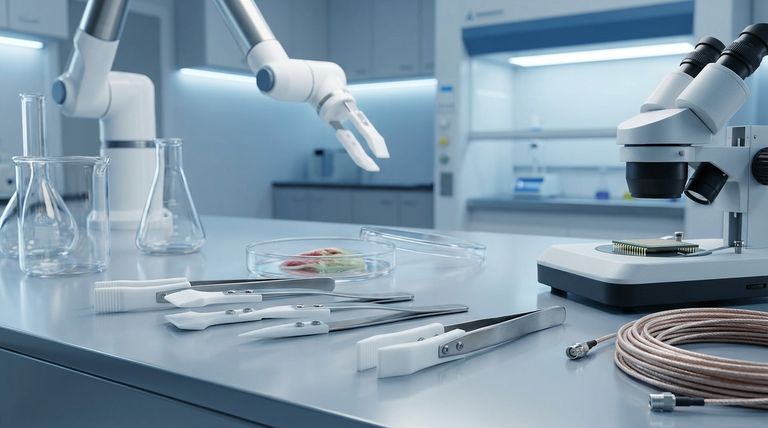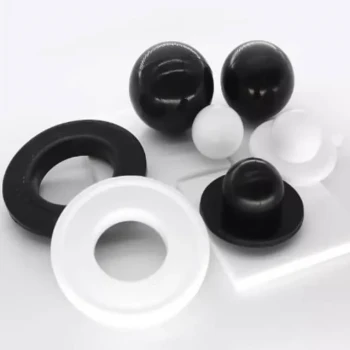In short, Polytetrafluoroethylene (PTFE) is used almost everywhere an extreme performance material is needed. Its applications range from non-stick coatings on cookware and stain-resistant fabrics to critical components in the aerospace, medical, and chemical processing industries, such as seals, bearings, and electrical cable insulation.
The widespread use of PTFE stems from its unique combination of four key properties: extreme chemical inertness, a very low coefficient of friction, high-temperature stability, and excellent dielectric strength. Understanding which property drives the application is the key to appreciating its value.

Why PTFE is so Versatile: A Property-Driven View
PTFE is rarely chosen for its structural strength. Instead, it is selected because it solves specific engineering challenges related to friction, chemical attack, temperature, or electrical insulation where other materials would quickly fail.
Unmatched Chemical Inertness
PTFE is virtually immune to attack from almost all corrosive chemicals, acids, and bases.
This non-reactive nature makes it the material of choice for components that handle aggressive substances. This includes seals, gaskets, washers, and linings for pipes, valves, pumps, and chemical reaction vessels.
It is also indispensable in scientific and semiconductor equipment where purity and resistance to contamination are critical.
The Ultimate Low-Friction Surface
PTFE has one of the lowest coefficients of friction of any known solid, giving it a uniquely slippery surface.
This property is famously used for non-stick coatings on pots and pans. In industrial settings, it is used for self-lubricating plain bearings, bushings, gears, and slide plates, allowing machinery to operate smoothly without external lubricants.
It also serves as a high-performance lubricant itself, reducing friction and wear between moving parts.
Superior Electrical Insulation
PTFE is an exceptional electrical insulator with a high dielectric strength, meaning it can withstand a strong electric field without breaking down.
This makes it an ideal material for insulating high-frequency wiring and coaxial cables, especially in computer and aerospace applications where signal integrity is paramount.
Components in transformers and other electrical equipment also rely on PTFE for reliable insulation.
Stability Across Extreme Temperatures & Environments
PTFE maintains its properties over a very wide temperature range, from cryogenic applications (-200°C) up to high-temperature uses (260°C).
This thermal stability allows it to be used in demanding environments like jet engine components and parts for UV lamps.
Furthermore, its hydrophobic nature makes it effective for weatherproofing coatings on outdoor signage and even the roofs of large structures like airports and stadiums.
Biocompatibility and Purity
Because PTFE is so inert, it is highly biocompatible and does not react with bodily fluids.
This has led to its widespread use in the medical field for devices like catheters, syringes, surgical implants, and vascular grafts.
Its purity and compliance with food-grade standards also make it essential in food and beverage manufacturing for components like conveyor belts and cooking equipment.
Understanding PTFE's Limitations
While incredibly useful, PTFE is not a universal solution. Its primary trade-offs are mechanical, not chemical or thermal.
Low Mechanical Strength
Compared to other engineering plastics, PTFE is relatively soft and has low tensile strength and wear resistance. It can be easily scratched.
For applications requiring more rigidity, such as in "bearing grades," PTFE is often blended with fillers like glass fiber, carbon, or bronze to enhance its mechanical properties.
Susceptibility to Creep
Under a sustained load, especially at elevated temperatures, PTFE can slowly deform over time. This phenomenon, known as "creep," must be accounted for in the design of structural components like seals and gaskets.
Difficult Processing
PTFE has an extremely high melting point and viscosity, which makes it impossible to process using conventional methods like injection molding. It must be processed using specialized techniques like sintering, which can increase manufacturing complexity and cost.
Making the Right Choice for Your Application
Selecting a material requires aligning its strengths with your primary goal. PTFE is a specialist material chosen to solve a specific problem.
- If your primary focus is chemical resistance: PTFE is the default choice for seals, linings, and tubing designed to handle the most aggressive chemicals.
- If your primary focus is low friction: It is the ideal solution for non-lubricated moving parts like slide plates, gears, and self-lubricating bearings.
- If your primary focus is electrical performance: Its exceptional dielectric properties make it essential for insulating high-frequency and high-performance cables.
- If your primary focus is purity or biocompatibility: Its inertness is critical for components used in medical devices, food processing, and semiconductor manufacturing.
Ultimately, PTFE's value lies in its ability to perform reliably where other materials simply cannot survive.
Summary Table:
| Key Property | Primary Application Examples |
|---|---|
| Chemical Inertness | Seals, gaskets, liners for chemical processing, labware |
| Low Friction | Non-stick coatings, self-lubricating bearings, gears |
| Electrical Insulation | High-frequency cable insulation, coaxial cables |
| Temperature Stability | Jet engine components, high-temperature seals |
| Biocompatibility | Medical implants, catheters, food processing equipment |
Need a PTFE component that can withstand your most demanding environment?
KINTEK specializes in manufacturing high-performance, precision PTFE components—including custom seals, liners, and labware—for the semiconductor, medical, laboratory, and industrial sectors. We handle everything from prototypes to high-volume orders, ensuring your parts meet exact specifications for chemical resistance, purity, and performance.
Contact our experts today to discuss your custom PTFE fabrication needs.
Visual Guide

Related Products
- Custom PTFE Parts Manufacturer for Teflon Parts and PTFE Tweezers
- Custom PTFE Parts Manufacturer for Teflon Containers and Components
- Custom PTFE Sealing Tapes for Industrial and High Tech Applications
- Custom PTFE Sleeves and Hollow Rods for Advanced Applications
- Customizable PTFE Rods for Advanced Industrial Applications
People Also Ask
- What are the main applications of PTFE type Teflon? Unlock Its Versatility for Your Industry
- What fabrication services are available for PTFE? Shearing, Stamping, Laser Cutting, Molding & Machining
- What chemical processing applications involve PTFE-machined parts? Essential Components for Corrosive & High-Purity Systems
- What finishing techniques are effective for machined Teflon parts? Achieve Functional Performance and Dimensional Stability
- What industrial benefits do PTFE-machined parts offer? Achieve Peak Performance in Demanding Applications



















